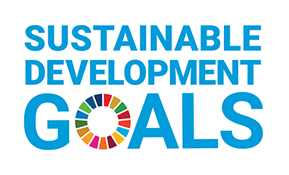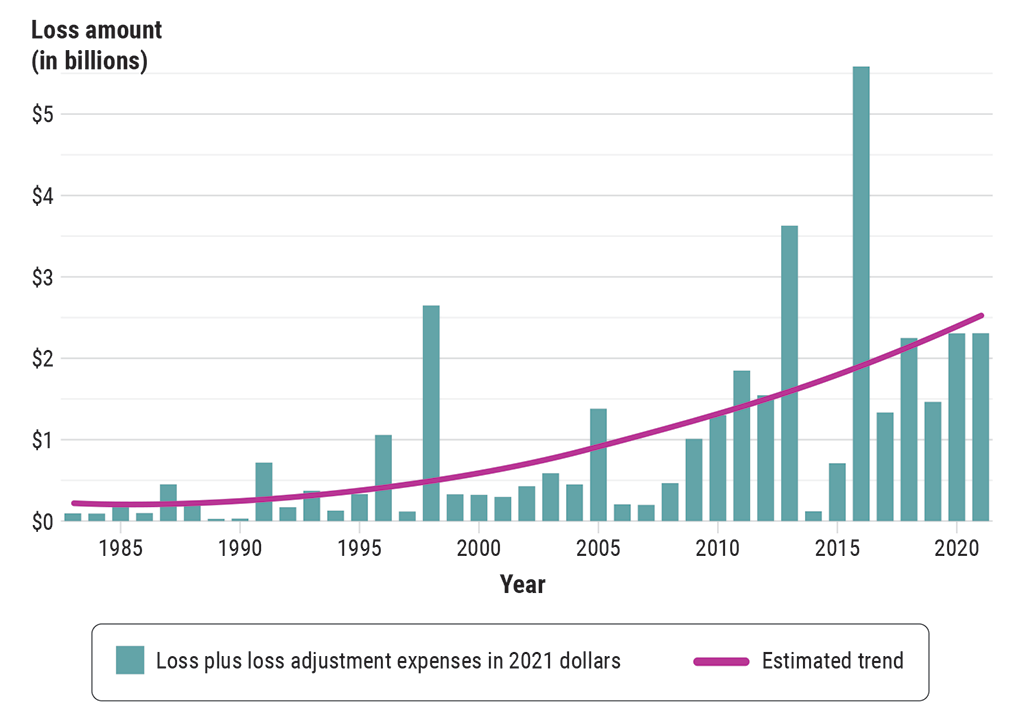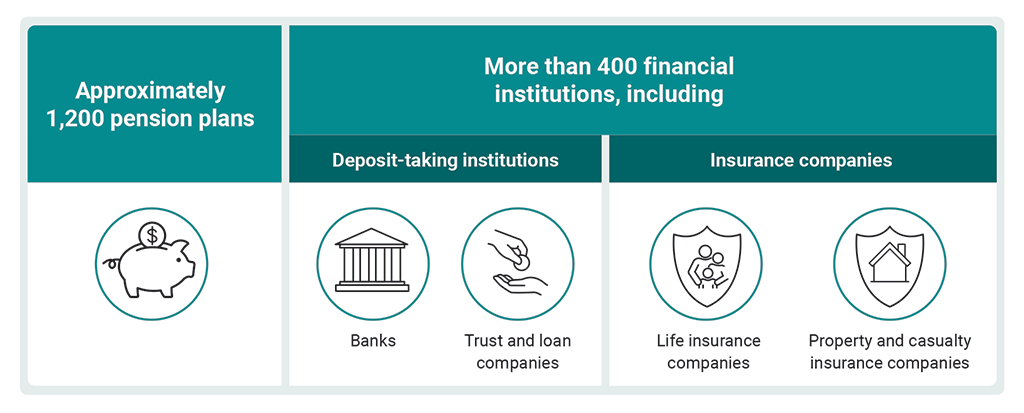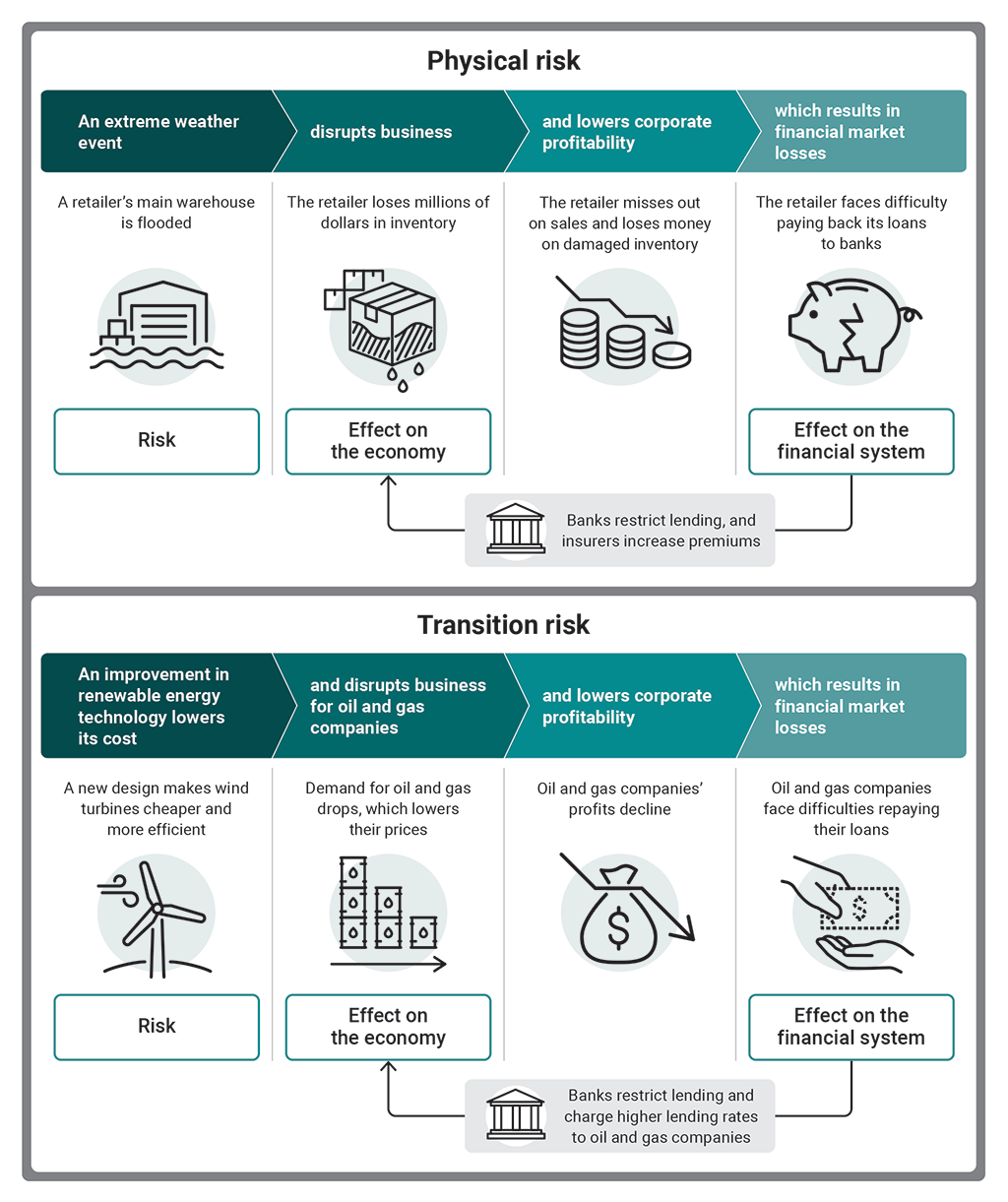2023 Reports 1 to 5 of the Commissioner of the Environment and Sustainable Development to the Parliament of Canada
Report 4—Supervision of Climate-Related Financial Risks—Office of the Superintendent of Financial Institutions Canada
At a Glance
Climate change poses significant risks to the safety and soundness of Canada’s financial system by affecting the operations of institutions and their balance sheets—we call these climate-related financial risks. Overall, the Office of the Superintendent of Financial Institutions Canada (OSFI), as a key supervisor of Canada’s financial institutions, has recently made meaningful progress toward integrating climate-related financial risks in its supervisory framework for federally regulated financial institutions, but more work is needed. As such, full implementation of climate-related financial risk supervision is still years away.
OSFI’s strategy aims at ensuring that financial institutions are resilient to adverse climate-related financial risks. For example, forest fires may lead to serious property damage and reduce households’ ability to repay mortgage loans, which would increase losses for financial institutions. Similarly, changes in government regulations and policies introduced to limit greenhouse gas emissions may lower companies’ revenues, reducing their ability to repay creditors. In our view, OSFI should consider whether it is appropriate to look beyond its current approach and find ways to advance Canada’s broader climate goals, as stated in the latest Federal Sustainable Development Strategy.
It is encouraging that OSFI and the international community of financial supervisors have recognized that climate change poses risks to financial institutions and the broader financial system and that they are moving forward in addressing this issue. But action is overdue and is now urgent.
Why we did this audit
- Climate change poses significant risks to the safety and soundness of Canada’s financial system.
- Appropriate consideration of climate-related financial risks in prudential supervision could support the Government of Canada’s goal of achieving net‑zero emissions by 2050.
- Climate-related financial risks must be incorporated formally into the supervisory frameworks if all regulated institutions are to be held to the same standards.
- It is important for OSFI to have a fully developed and implemented approach to address climate‑related financial risks before they pose a risk to the resilience of financial institutions and, ultimately, to deposit holders and insurance policyholders.
Key findings
- OSFI has begun implementing a sound strategy to address climate-related financial risks. However, as tackling climate-related financial risks only recently became one of OSFI’s priorities, full implementation of the strategy in supervisory activities is still years away.
- OSFI’s strategy to tackle climate-related financial risks aims to improve the resilience of federally regulated financial institutions but will remain short of incentivizing the transition to a net-zero emissions economy.
- It remains unclear how the main climate-related financial risks will feature in OSFI’s updated supervisory framework. If these risks are not prominent enough, they might not be fully addressed in a timely manner.
Key facts and figures
- Catastrophic climate events, such as forest fires, floods, and landslides, are happening more frequently and with increased severity, with insured losses from these events rising tenfold in Canada since 1983.
- Some governments, such as the United Kingdom and the European Union, have aligned financial supervisors’ mandates with sustainability objectives, while Canada and others have not.
- Climate-related financial risks involve longer delays between actions and effects compared with conventional financial risks. There is also less information available now to quantify financial risks that are due to climate than those that are due to other factors.
Highlights of our recommendations
- OSFI should increase the frequency and breadth of its public outreach to engage more broadly and benefit from the perspectives and expertise of civil society about climate-related financial risks and potential tools to address them.
- OSFI should ensure that its strategy for addressing climate-related financial risks is as consistent as possible among federally regulated pension plans and federally regulated financial institutions, in terms of data, disclosures, vulnerability analyses, and regulatory and supervisory practices.
Please see the full report to read our complete findings, analysis, recommendations and the audited organizations’ responses.


The Federal Sustainable Development Strategy includes the United Nations’ Sustainable Development Goal 13 (climate action), which states, “Take urgent action to combat climate change and its impacts.” In the federal strategy, this action involves
- strengthening resilience and capacity to adapt to climate-related hazards and natural disasters
- integrating climate change measures into national policies, strategies, and planning
- improving education, awareness-raising, and human and institutional capacity on climate change
Now that it is designated under the Federal Sustainable Development Act, OSFI, reporting to the Minister of Finance, has new obligations, including developing its first departmental sustainable development strategy in 2023 and reporting on its progress in 2024 and 2025. OSFI’s upcoming strategy is required to contribute to meeting the federal strategy’s goals. The federal strategy’s whole‑of‑government approach to sustainable development has ambitious goals, including a target of achieving 40% to 45% greenhouse gas emission reductions below 2005 levels by 2030 and achieving net‑zero greenhouse gas emissions by 2050.
Visit our Sustainable Development page to learn more about sustainable development and the Office of the Auditor General of CanadaOAG.
Exhibit highlights
Insured losses from catastrophic weather events in Canada

A catastrophic loss is 1 event costing $25 million or more.
Text version
This bar chart shows the amount of insured losses from catastrophic weather events in Canada from 1983 to 2021. A catastrophic loss is 1 event costing $25 million or more. The estimated trend for these losses is a steady increase from 1983 to 2021.
The loss plus loss adjustment expenses by year in billions of 2021 dollars is as follows.
| Year | Loss plus loss adjustment expenses in billions of 2021 dollars |
|---|---|
| 1983 | $0.09 billion |
| 1984 | $0.09 billion |
| 1985 | $0.23 billion |
| 1986 | $0.10 billion |
| 1987 | $0.45 billion |
| 1988 | $0.22 billion |
| 1989 | $0.03 billion |
| 1990 | $0.03 billion |
| 1991 | $0.72 billion |
| 1992 | $0.17 billion |
| 1993 | $0.37 billion |
| 1994 | $0.13 billion |
| 1995 | $0.33 billion |
| 1996 | $1.06 billion |
| 1997 | $0.12 billion |
| 1998 | $2.65 billion |
| 1999 | $0.33 billion |
| 2000 | $0.32 billion |
| 2001 | $0.30 billion |
| 2002 | $0.43 billion |
| 2003 | $0.59 billion |
| 2004 | $0.45 billion |
| 2005 | $1.38 billion |
| 2006 | $0.20 billion |
| 2007 | $0.20 billion |
| 2008 | $0.47 billion |
| 2009 | $1.01 billion |
| 2010 | $1.30 billion |
| 2011 | $1.85 billion |
| 2012 | $1.55 billion |
| 2013 | $3.63 billion |
| 2014 | $0.12 billion |
| 2015 | $0.71 billion |
| 2016 | $5.58 billion |
| 2017 | $1.33 billion |
| 2018 | $2.25 billion |
| 2019 | $1.46 billion |
| 2020 | $2.31 billion |
| 2021 | $2.31 billion |
The Office of the Superintendent of Financial Institutions Canada regulates and supervises hundreds of financial institutions

Text version
This diagram shows the number of pension plans and financial institutions that the Office of the Superintendent of Financial Institutions Canada regulates and supervises. There are approximately 1,200 pension plans and more than 400 financial institutions. The more than 400 financial institutions include not only deposit‑taking institutions, such as banks and trust and loan companies, but also insurance companies, such as life insurance companies and property and casualty insurance companies.
Examples of how the 2 types of climate-related financial risks can affect the economy and financial system

Text version
This exhibit gives examples of how a physical risk, such as a flood, and a transition risk, such as a technology change, can affect the economy and financial system. Physical risks and transition risks are the 2 types of climate-related financial risks.\
The example of how a physical risk can affect the economy and financial system is the following: An extreme weather event disrupts business and lowers corporate profitability, which results in financial market losses. This example is illustrated as follows:
- A retailer’s main warehouse is flooded. This is the risk from an extreme weather event.
- The retailer loses millions of dollars in inventory. This is the effect on the economy from the business disruption for the retailer.
- The retailer misses out on sales and loses money on damaged inventory, thus corporate profits decline.
- The retailer faces difficulty paying back its loans to banks. This is the effect on the financial system from the retailer’s financial losses.
- This effect on the financial system results in banks restricting lending and insurers increasing premiums. These actions affect the retailer that lost millions of dollars in inventory and also affect the economy.
The example of how a transition risk can affect the economy and financial system is the following: An improvement in renewable energy technology lowers its cost, disrupts business for oil and gas companies, and lowers corporate profitability, which results in financial market losses. This example is illustrated as follows:
- A new design makes wind turbines cheaper and more efficient. This transition to the improved renewable energy technology is a risk for the economy and the financial system.
- Demand for oil and gas drops, which lowers their prices. This is the effect on the economy from the business disruption for oil and gas companies caused by the technology transition.
- Oil and gas companies’ profits decline.
- Oil and gas companies face difficulties repaying their loans. This is the effect on the financial system from the oil and gas companies’ financial losses.
- This effect on the financial system results in banks restricting lending and charging higher lending rates to oil and gas companies. These actions affect the oil and gas companies that had to lower their prices because demand dropped and also the economy.
Infographic

Text version
Supervision of Climate-Related Financial Risks—Office of the Superintendent of Financial Institutions Canada
Climate change poses significant risks to the safety and soundness of Canada’s financial system by affecting the operations of institutions and their balance sheets—we call these climate-related financial risks. The Office of the Superintendent of Financial Institutions Canada is one of Canada’s key prudential supervisors and has a central role to play in ensuring that our financial institutions consider and plan for these risks.
Example of a climate-related financial risk
A flood affects a whole community.
Damage is extensive, and many homeowners struggle to pay their mortgage loans.
Financial institutions suffer monetary losses. Banks may restrict lending, and insurers may increase premiums.
What could happen if we do not plan for these risks?
Significant losses could result in a financial institution failing.
Weaknesses in one financial institution could reveal weaknesses in other financial institutions, starting a domino effect.
Impacts of climate change
Climate change will cause more frequent and extreme weather events. Addressing climate change will require costly actions.
Delays in acting on climate change
But delaying actions to address climate change will make needed actions and severe weather events even more costly in the future.
It’s an uphill battle
The Office of the Superintendent of Financial Institutions Canada has made some progress toward integrating climate-related financial risks in its supervisory framework, but more work is needed.
Full implementation of climate-related financial risk supervision is still years away, and action is already overdue and urgent.
Related information
Tabling date
- 20 April 2023
Related audits
- 2021 Reports 3 to 7 of the Commissioner of the Environment and Sustainable Development
Report 5 Lessons Learned from Canada’s Record on Climate Change - 2018 Spring Reports of the Commissioner of the Environment and Sustainable Development to the Parliament of Canada
Report 2—Canada’s Preparedness to Implement the United Nations’ Sustainable Development Goals - Commissioner of the Environment and Sustainable Development
Research Paper on Climate-related Financial Disclosures
Parliamentary hearings
